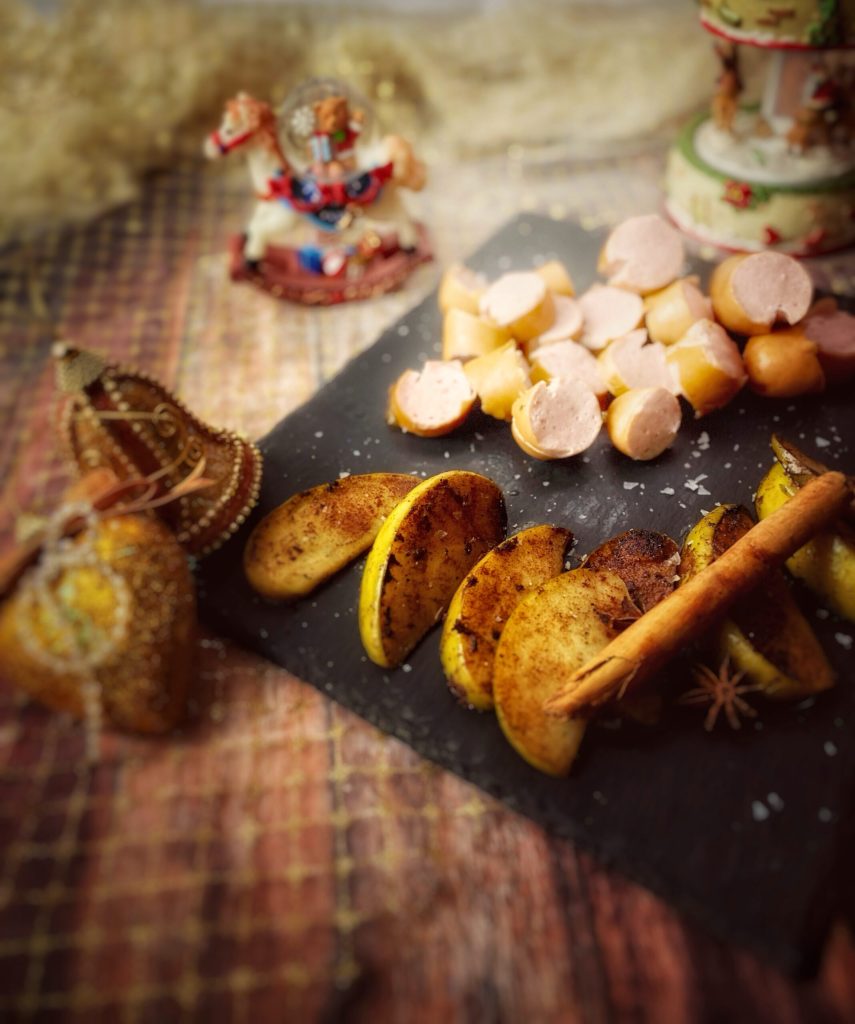The Boudin are various types of sausage in the French, Luxembourgish, Belgian, Swiss, Québécois, Acadian, Valdostan, Louisiana Creole, and Cajun cuisine.
The Anglo-Norman word boudin meant “sausage”, “blood sausage”, or “entrails” in general.
Among the various existing types, we find the Boudin blanc, which contrary to popular belief is not a chicken sausage, but is made from white meats (pork lean, poultry, veal), and originally, was a white pork sausage without blood.
Its variants include:
• French Boudin blanc, with milk. The recipe that follows in its simplified homemade version.
• The boudin blanc de Liège: a Belgian version similar to the French Boudin blanc, but with marjoram and a protected geographical indication.
• Cajun boudin blanc, made with a mixture of pork, rice, onions, and seasonings similar to dirty rice (a traditional Louisiana Creole dish made with white rice that turns “dirty” as it is cooked with small pieces of pork, beef, or chicken, green bell pepper, celery, and onion) and stuffed into sausage casings.
Local variations may also include liver or other pork offal or other meats such as venison, alligator, and shrimp, and can vary in terms of spiciness.
• And the boudin blanc de Rethel: a traditional French boudin, which can only contain pork, whole fresh eggs, and milk, and cannot contain breadcrumbs or flours or starches.
It is protected by EU regulations with protected geographical indication status.
• Finally, the boudin ball: another Cajun variation of the boudin blanc. Instead of stuffing the filling into a pork casing, it is rolled into a ball, battered, and fried.
The history of Boudin blanc is recent as it appeared in its current form only in the 17th century.
However, it seems to date back to the Middle Ages when it was customary to eat, before Christmas lunch, a polenta made from milk, breadcrumbs, fat, starch, and sometimes pieces of boiled ham or poultry.
It was only during the Age of Enlightenment that a cook, who remained anonymous, had the idea of serving this preparation, making it more substantial, in pork casings so that it was worthy of being served at noble tables during Christmas lunch.
It is usually consumed both cold and hot (in a pan or on the grill), cooked “nude” in butter or with its casing.
Some spicy varieties are also suitable for barbecue.

- Difficulty: Difficult
- Cost: Medium
- Preparation time: 20 Minutes
- Portions: 6 pieces
- Cooking methods: Stove, Boiling
- Cuisine: French
- Seasonality: Christmas
Ingredients
- Pork casing
- 7 oz chicken
- 7 oz veal
- 7 oz pork
- 2.5 cups milk
- 3 eggs
- 2 onions
- 1/3 cup cornstarch
- 2 cups breadcrumbs
- to taste salt and pepper
- to taste nutmeg
- to taste butter
- to taste vegetable broth
Tools
- 1 Meat Grinder
- 1 sausage stuffer
Steps
First, rinse the casings with water, then soak them in water to restore their elasticity.
Soak the breadcrumbs in milk and, in the meantime, slice the onions and fry them in butter until translucent.Cut the meat into pieces and pass them through the grinder.
Then pass, in the same way, the soaked breadcrumbs and then the cooled onions. Keep the milk aside.
Mix the ground meat, bread, and onions.Add the eggs, milk, cornstarch, salt, pepper, grated nutmeg, and mix well so that the preparation is homogeneous. If necessary, add more milk until you get the desired consistency.
Fit the casing onto the sausage stuffer or grinder funnel and push the mixture into it.
Tie the end of the casing, releasing air from the casing.
Do not force the filling, as the bread will swell during cooking and tighten the casing.
Immerse the sausages in broth or hot water for about 20 minutes.
Let cool in the broth.
Melt the butter in a pan and brown the sausages, giving them a light and uniform blond color.
Serve them alone or with a garnish of apples sautéed with cinnamon (as I did) or with an apple compote.

FAQ (Questions and Answers)
What other types of boudin are there?
– Boudin noir: a dark-colored blood sausage, containing pork, pork blood, and other ingredients.
Variants of the boudin noir are found in French, Belgian, Cajun and Catalan cuisine.
The Catalan version is called botifarra negra.
In the French Caribbean, it is known as boudin Creole with local names, such as boudin rouge Antillais in Guadeloupe, and infused with spices or rum.
In Britain, a similar sausage is called “black pudding“, the word “pudding” is an anglicized pronunciation of boudin and likely introduced after the Norman conquest.
– Boudin rouge: in Louisiana cuisine, a sausage similar to Cajun boudin blanc with the addition of pork blood, although less commonly produced.
– Boudin vert: a green sausage made from pork, cabbage, and kale. Popular in the Belgian province of Walloon Brabant.
– Boudin valdôtain, from the Aosta Valley, a blood sausage with red beet, potatoes, spices, wine, and beef or pork blood.
– Brown rice boudin: a variant made with brown rice that has a taste similar to traditional pork boudin.

